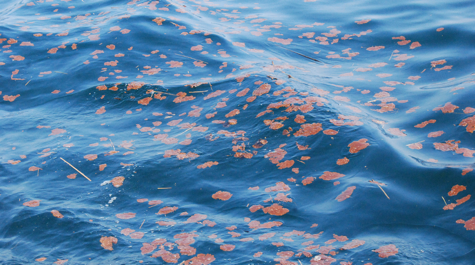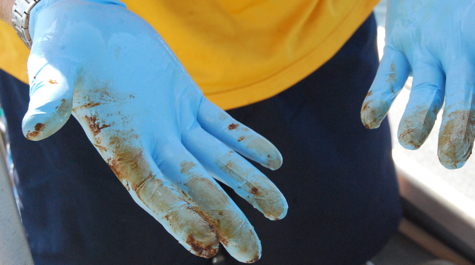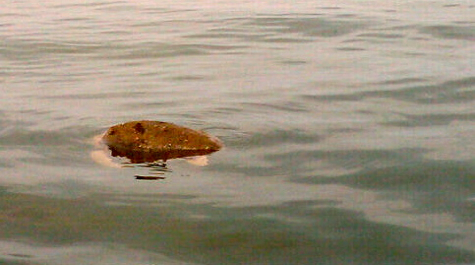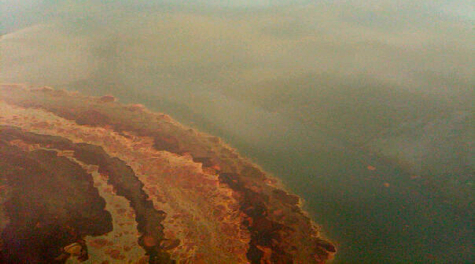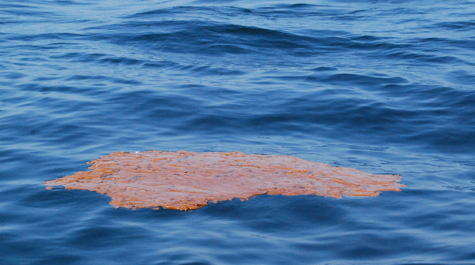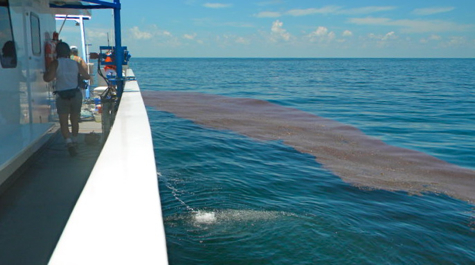Oil & Water
Article reprinted from the Fall 2010 issue of the William & Mary Alumni magazine with permission of the Editor.
It’s a rainy Saturday morning in late July at the Mockingbird Café in Bay St. Louis, Miss., and Michael “Mike” Carron M.S. ’76, Ph.D. ’79 is doing his best to describe the impact of the BP oil spill on the Gulf Coast region where he grew up.
“All of us who live along the Gulf are pretty emotional about what has happened here,” says the 64-year-old marine scientist, who studied under legendary oceanographer John Zeigler at William and Mary’s Virginia Institute of Marine Science (VIMS) and is now executive director of Mississippi’s Northern Gulf Institute (NGI) ocean research facility. “We know the potential is here for long-term damage to a world we love.”
The oil spill — the largest in history — began on April 20 following an explosion and fire aboard the Deepwater Horizon, an offshore drilling rig operated by BP. The accident killed 11 workers and then spewed an estimated 150-200 million gallons of crude oil into the ecologically fragile Gulf of Mexico over the next several months. The spill could ultimately cost the region up to $5 billion in lost revenue from tourism, commercial fishing and other economic enterprises linked to the Gulf, according to the latest federal estimates.
“When you grow up along the Gulf of Mexico like I did, you get pretty invested in the natural beauty, in the fish and the turtles and the seabirds,” Carron says. “You come to love all of that — and when it gets hit with the kind of pollution from crude oil that we’re now seeing on the beaches and offshore at times, well, that really hurts a lot.”
A Major Scientific Challenge
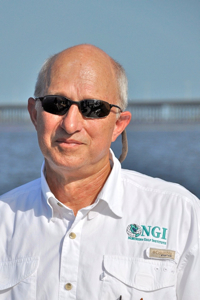 Carron points out, however, that he doesn’t have much time to spend on regret or nostalgia right now, and for good reason. As the executive director of NGI — a nonprofit marine research think tank that includes five area universities, a regional center of the National Oceanic and Atmospheric Administration (NOAA) and several other environmental research groups — Carron is now leading a massive scientific effort to understand the ecological impact of the spill on the millions of sea creatures that live in and around the Gulf of Mexico.
Carron points out, however, that he doesn’t have much time to spend on regret or nostalgia right now, and for good reason. As the executive director of NGI — a nonprofit marine research think tank that includes five area universities, a regional center of the National Oceanic and Atmospheric Administration (NOAA) and several other environmental research groups — Carron is now leading a massive scientific effort to understand the ecological impact of the spill on the millions of sea creatures that live in and around the Gulf of Mexico.
He has been running almost nonstop since April. Within a few days of the initial oil leak, he began directing several NGI teams (including about two dozen marine scientists) in preliminary studies aimed at measuring the impact of the oil on the Gulf’s ecosystem. Under his direction, NGI scientists are also trying to understand the ecological effects that may have been caused by the 1.5 million gallons of chemical dispersant added to the oil at a mile of depth.
“Right now, it’s too early to tell what the overall impact will be,” says Carron as he sits over a cup of early-morning coffee in Bay St. Louis. “We’ve got researchers studying the impact of the oil on phytoplankton and zooplankton, and others are looking at fish larvae and turtles and birds.
“We know that a lot of the oil was dispersed at depth, which means the bacteria will ultimately eat it. But what we don’t know right now is how that will affect oxygen levels in the water column — and whether or not the spill will interfere with the breeding process among fish and turtles, for example.
“Within a year or two, we’ll be able to start measuring the populations of various Gulf species, and that will tell us a lot about the ecological impact. But right now the jury is still out, and I think all of us who care about the Gulf are kind of holding our collective breath.”
A 1968 Naval Academy grad, Carron enjoyed a long career as a U.S. government marine scientist after earning his master’s and doctoral degrees at VIMS. Following his retirement as chief scientist of the Naval Oceanographic Office, he spent five years in Italy studying the impact of Naval sonar on whales. He signed on as NGI chief scientist in 2007 and became director this year.
“Dealing with a highly complex event like the oil spill is a major scientific challenge,” says Carron, whose wife Susan ’72 and son Christopher ’04 are also W&M graduates. “Dr. Zeigler was a father figure, and some of the lessons I learned from him at William and Mary have proved very helpful in our investigation.
“We won’t know the final outcome until we start counting pelicans and turtles in a couple of years, but our fingers are crossed and we’re all hoping that the data we’re now gathering will mean good news in the months and years ahead.”
From Marshes to Microorganisms
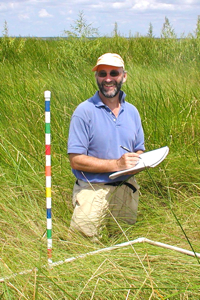 Other VIMS-trained scientists, both veterans and recent graduates, are hard at work examining different aspects of the Gulf’s complex ecology. Dr. Irving Mendelssohn M.S. ’73, a wetlands ecologist at Louisiana State University in Baton Rouge, has been studying the impact of the spill on marsh grasses and other plants that live in the brackish waters along the Louisiana coastline. Like Mike Carron, he finds some signs for optimism.
Other VIMS-trained scientists, both veterans and recent graduates, are hard at work examining different aspects of the Gulf’s complex ecology. Dr. Irving Mendelssohn M.S. ’73, a wetlands ecologist at Louisiana State University in Baton Rouge, has been studying the impact of the spill on marsh grasses and other plants that live in the brackish waters along the Louisiana coastline. Like Mike Carron, he finds some signs for optimism.
“I can understand the gloom and doom that a lot of people are feeling, because there really is a great deal of oil out there in the Gulf, and if it does start to come ashore at some point, the results could be devastating,” notes the 62-year-old scientist.
“But at the moment, the actual oiling of the marshes is fairly limited. If we don’t get too much more oil into the marshes, we may be in good shape,” Mendelssohn says. “Things could change — especially if we get a hurricane or two through here — but for right now, the impact on the wetlands seems manageable, even if some spots along the coast have been severely hit by oil. Right now, though, I think it’s very difficult to predict the ultimate impact with any certainty.”
According to the LSU investigator, however, most marsh plants in even the hardest-hit areas of the Louisiana coast seem to be surviving in spite of having been oiled. “I think that’s a very good sign,” he notes, “and if they continue to hang on in spite of the oil, it does suggest that the overall effects will be minimal in the wetlands.”
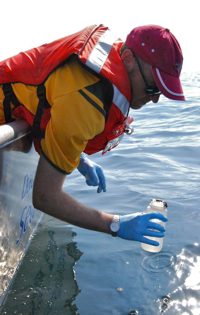 At the Dauphin Island Sea Lab (DISL) — a state-run research consortium that provides ecological data and oceanographic training to 21 colleges and universities in Alabama — marine scientist Rob Condon Ph.D. ’08 is examining the impact of the oil spill on the “food web” shared by animals living in the Gulf of Mexico.
At the Dauphin Island Sea Lab (DISL) — a state-run research consortium that provides ecological data and oceanographic training to 21 colleges and universities in Alabama — marine scientist Rob Condon Ph.D. ’08 is examining the impact of the oil spill on the “food web” shared by animals living in the Gulf of Mexico.
“My focus has been on looking at the oil and how it dissolves in water and then affects microorganisms such as bacteria and the flagellates,” Condon says. “At this point, there are so many question marks out there that it’s very hard to be sure about the ultimate impact of the spill on the Gulf ecology.
“We also have to remember that there’s a lot of dispersant in the water column — and we have no idea at all what that dispersant does to the food web. Does it kill the phytoplankton? If so, how does that affect the animals higher up in the food chain? I’m very concerned, but there are many unknowns, and the environmental impact [of the spill] is highly uncertain.
“I think the only way we can answer these questions is to go ahead and actually do the science — and that’s going to take a while.”
Meanwhile, in a busy laboratory at Virginia Commonwealth University in Richmond, Va., marine biologist S. Leigh McCallister Ph.D. ’02 is working feverishly on the same bacterial studies that have been occupying Rob Condon and his colleagues at DISL for the past couple of months.
“What we’re trying to determine is how much of the crude oil is being consumed by bacteria,” says McCallister, who specialized in chemical and biological oceanography at VIMS. “We’re also looking for evidence of the movement of oil into the atmosphere as CO?, or into marine animals such as zooplankton, jellyfish and fish via what we call the ‘microbial loop.’
“This information could provide a handle on gauging the bioremediation [natural elimination of oil from the Gulf] which is occurring and the remaining threat to the ecosystem.”
Lessons to Be Learned
At the same time that scientists are trying to predict the ultimate impact of the spill on the Gulf, others are attempting to ensure that such a disaster never happens again.
On May 21, President Barack Obama issued an executive order establishing the National Commission on the Deepwater Horizon Oil Spill and Offshore Drilling, tasked with providing recommendations on how the United States can prevent and mitigate the impact of any future spills that result from offshore drilling. Dr. Donald Boesch Ph.D. ’71, a longtime marine scientist and president of the University of Maryland Center for Environmental Science (UMCES), was officially appointed to the commission in June.
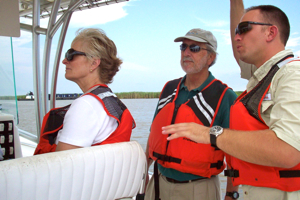 Boesch says the commission’s “charge is to understand what happened in the Gulf, and to understand the conditions and [regulatory] policies that led up to that.
Boesch says the commission’s “charge is to understand what happened in the Gulf, and to understand the conditions and [regulatory] policies that led up to that.
“It will be our task to try and learn everything we can about the spill, both past and present, in order to help the country develop policies that will prevent another such incident,” he says. “That’s a big challenge, and I’m honored to have been chosen for the panel that will attempt to meet it.
“At a minimum, we already know it’s an economic tragedy for many people along the Gulf,” says the New Orleans native. “But we haven’t gathered all the data on the environmental damage yet, and we won’t know for sure about that until all the results are in.”
Boesch says he feels “especially well-prepared for the challenge” — since he had previously studied oil spills and their effect on the environment as a young professor at VIMS. He’s written numerous publications about the subject, beginning with the book Oil Spills and the Marine Environment published in 1974.
“We’re going to be working very hard on the commission in the days ahead,” he says, “hoping to learn more about what led up to this disaster, and about its ultimate impact. We’ll be holding public hearings and looking at a great deal of scientific research. But my biggest concern right now is whether or not we’ll learn the lessons we need to learn from this tragedy as a society.
“In this country, we tend to pay attention when there’s a crisis like this taking place, and then later we lose our focus. But I think it’s really important that we don’t allow that to happen in the case of the oil spill.”
Watching and Waiting
So what’s the bottom line, now that BP has finally capped its runaway well and the oil has stopped flowing into the Gulf?
One fact is indisputable: the spill has altered the lives and livelihoods of thousands of people.
“For many people in this area, the disaster has already occurred. You’ve got a lot of people taking a tremendous hit down here,” Irving Mendelssohn says. “The tourist industry is decimated in many areas, and you’ve got fishermen who can’t get out to their sites, which have been closed down by the state and federal governments.
“These people are suffering. There’s tremendous anxiety, and many of them are going to need our help for a long time.”
As for the longer term effects, the VIMS scientists agree that it’s too early to predict with any certainty.
“Right now, we’re looking at a whole lot of questions that we just don’t have answers for,” Mike Carron says. “If we start to see oil moving up the food chain — from fish and crab and shrimp larvae on up into the larger species — then that will signal some very serious potential problems, and we could see some species taking a major hit.
“The danger of having oil get into the food chain is that it will become concentrated in the animals that feed at the top of the chain, and you could get some severely toxic effects for them out of that.”
Rapping on the nearest tabletop at Mockingbird Café, Carron adds: “Right now, a lot of us are knocking on wood. To this point, it looks as if we’ve managed to dodge a major ecological bullet — but there’s no guarantee that the disaster is over yet.
“The oil spill is an extremely complex ecological event and it has taken place on a scale we’ve never really experienced before. Nobody knows for sure what the ultimate impact will be, and I think everyone involved understands that we’re just going to have to watch and wait.”

